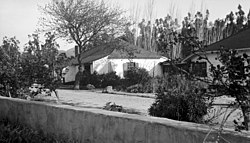Rancho Camulos
|
Rancho Camulos
|
|

A view of Rancho Camulos from the northwest.
|
|
| Location | 5164 East Telegraph Road, Piru, California |
|---|---|
| Coordinates | 34°24′24″N 118°45′24″W / 34.40667°N 118.75667°WCoordinates: 34°24′24″N 118°45′24″W / 34.40667°N 118.75667°W |
| Built | 1853 |
| Architectural style |
Spanish Colonial Mission Revival Spanish Colonial Revival |
| NRHP Reference # | 96001137 |
| CHISL # | 553 |
| Significant dates | |
| Added to NRHP | November 1, 1996 |
| Designated NHL | February 16, 2000 |
| Designated CHISL | 1956 |
Rancho Camulos, now known as Rancho Camulos Museum, is a ranch located in the Santa Clara River Valley 2.2 miles (3.5 km) east of Piru, California and just north of the Santa Clara River, in present day Ventura County, California. It was the home of Ygnacio del Valle, an alcalde of the Pueblo de Los Angeles and member of the California State Assembly. The ranch was known as the Home of Ramona because it was widely believed to have been the setting of the popular 1884 novel Ramona by Helen Hunt Jackson. The novel helped in raising awareness about the Californio lifestyle and "romanticizing of the mission and rancho era of California history."
The 1,800-acre (7 km2) working ranch is a prime example of an early California rancho in its original rural setting. It was the source of the first commercially grown oranges in what is now Ventura County, and is one of the few remaining citrus growers in Southern California.
State Route 126 bisects the property, with most of the main buildings located south of the highway, and a few buildings on the north. The main adobe is one of the few extant Spanish Colonial buildings left in the state. Most of the other buildings are done in Mission Revival or Spanish Colonial Revival styles, both of which are derivatives of the original.
...
Wikipedia


